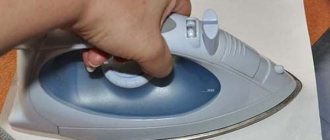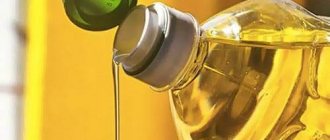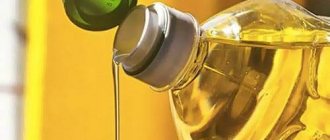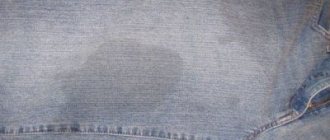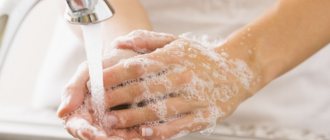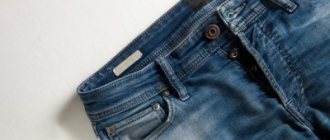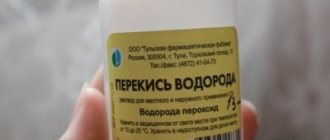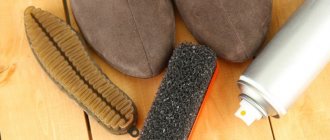Preparing items for cleaning
Regardless of the degree of the stain and the time of its occurrence, the suede product should be pre-prepared, based on a number of recommendations:
- If you notice contamination immediately, you should blot it with a damp cloth. This will prevent further spread and penetration of fat.
- Remove dirt only from dry material. If the item is wet, the risk of the stain spreading increases.
- Pre-test the reaction of your chosen product on an inconspicuous area.
- If you use store-bought products, be sure to check their suitability for cleaning suede by carefully reading the instructions for use on the package.
Important: suede products should be dried exclusively naturally, without placing them near a radiator. At the end of the process, use a special brush to remove any remaining product and dirt.
Important Tips
Before putting on new suede shoes, treat them with a special protective spray. Use the product according to the season. For winter, autumn and early spring it is better to use water-repellent sprays. They allow the suede to remain dry even on very wet roads. In addition, after the sole and upper material dry, the suede remains beautiful and fleecy. For summer shoes made of special leather, it is better to use dust-repellent compounds. They preserve the brightness of a black product and the freshness of light-colored shoes.
After treating the suede with the spray, let it sit for at least three hours and only then put on your shoes. Renew the spray layers periodically approximately once every 2-3 weeks or as appropriate.
Interesting: How to clean a greasy sofa
How to remove grease stains from suede using professional means
In specialized stores you can purchase products for cleaning products made from this material. They help remove stains from the surface, taking into account the characteristics of the raw materials used in production. However, you can try commercial drugs of a different type.
Stain remover Vanish
A universal product that allows you to remove dirt of any complexity. To achieve the result, it is necessary to apply the product to the damaged area (the amount depends on the size of the treatment area), leave for about a quarter of an hour, and then rinse with water.
Gel for washing woolen products
You can also use it to remove oily blots. To do this, dilute the product according to the instructions in water, beat into foam. Afterwards, the resulting solution is treated with a local area in the direction of the villi. Cleaning “against the grain” is strictly not recommended to avoid compromising the integrity of the material’s texture.
After the stain has disappeared, wipe the surface with a damp, lint-free cloth and dry naturally. To consolidate the effect, you can steam the item with an iron.
Fighting scuffs
Almost all suede shoes become scuffed over time and become unattractive. You can get rid of scuff marks yourself at home. To do this you need:
- Buy a coloring spray at a household chemical store;
- Put your shoes on;
- Lay a newspaper and stand on it;
- Spray the spray on shoes from all sides;
- Leave it in a well-ventilated area or outside until it dries.
Note! You can paint sneakers only indoors with good ventilation or outdoors. By not following these rules, you risk your health.
This method is guaranteed to remove scuffs from your favorite boots or shoes, and you can continue to use them.
How to withdraw using folk methods
Sometimes it is not possible to buy the desired product in a store or solving the problem requires immediate action. In these cases, use available means.
Alcohols
If you have ammonia in stock, take it and add laundry soap. To prepare the solution, you need to dilute a teaspoon of detergent and two ammonia in 200 ml of warm water. Afterwards, the resulting composition is used to treat the contaminated area until it disappears. Finally, the product is placed over a pan of steam for a couple of minutes.
Another type of alcohol also works great for greasy blots. To do this, the reagent is dissolved in water in a ratio of 1:10. In all other respects, the procedure remains unchanged.
Vinegar
You can remove oil deposits at home with vinegar. Preference should be given to the table with a concentration of 9%. A teaspoon is dissolved in a liter of water, and the resulting solution is used to treat the area with the blot. There is no need to rinse off the product at the end of the process. It will not leave marks and will not spoil the material.
Dishwashing liquid
The easiest way to clean the surface is to use dish gel, the effectiveness of which is due to the aggressiveness of the product towards grease. However, it should not be applied to the stain. It is necessary to dilute a tablespoon of washing liquid in a glass of water and beat it into a dense foam with a whisk, which is then applied to the local area. After a few minutes, the bubbles are removed with a dry cloth.
Milk and soda
A great way to remove stains of any nature. To obtain a solution, add a tablespoon of soda powder and a couple of drops of ammonia to a glass of heated milk. Then the dirt is treated with a cloth soaked in liquid.
Petrol
You can also use fuel, but preference should be given to purified fuel. A cotton pad is moistened with the substance, which is then used to treat the stain. To remove chemical traces, use a solution of liquid and dishwashing detergent.
Hydrogen peroxide
This preparation can also be used to clean nubuck; it is applied to the dirt with a cosmetic sponge and gently rubbed until the blot disappears.
Important: it is preferable to use the medication for light-colored products.
Steam
It is recommended to resort to temperature wet cleaning if other methods are unsuccessful. To do this, heat a sufficient amount of liquid in a pan, and when it begins to evaporate, place a thing above it at a distance of at least 10 centimeters. It is important here to prevent moisture from entering the surface of the product to avoid damage.
As an alternative, you can use special steamers. Upon completion of the procedure, the surface should be wiped dry.
Coffee grounds
It is permissible to use only on dark things. The mixture is applied to the oil mark and left until it dries. Afterwards it is removed with a rubberized brush.
Professional care
Preserving the unique texture of suede and keeping it in good condition requires certain tools and skills. Today's variety of effective products for caring for this material makes it easy to select protective products for products of any type and color. Regular use of professional cosmetics for the care of suede shoes and clothing minimizes the negative impact of external factors and prolongs the life of your favorite things.
What should be in your home care arsenal:
- Water-repellent impregnation with silicone, thanks to which pile leather can resist the harmful effects of moisture and will not be afraid of dirt or dust.
- Foam shampoo, which copes well with salt stains, instantly removes dirt and deepens color.
- An aerosol paint that prevents color loss and restores rough spots on suede.
- Sponge brushes for removing dry dirt, restoring the velvety of the material, cleaning welts and seams.
- To remove stubborn stains, it is most convenient to use hard sponges that draw in dirt or loose erasers that remain in the stains and are then removed with a brush.
- Erasers for restoring shiny areas and hairiness.
- Several special brushes for delicately removing dirt and restoring worn, smoothed bristles. The most convenient combination option in this regard is a “2 in 1” brush, where one side is a rubberized comb, and the other is a rubber surface with short bristles.
The safest method of treating suede is considered to be sequential passage of a brush over the contaminated surface.
The advantage of mechanical dry cleaning is the delicate and at the same time deep cleaning of the pile in the most inaccessible areas between the piles. The bristles comb through them efficiently, removing dried dirt, dust, and fatty deposits. The brush returns the original fluffiness to the pile leather, making things made from it look like new.
Dry cleaning of suede shoes and accessories
Absorbents include river sand, tooth powder, talc, soda or starch. The effectiveness in this case is due to the excellent absorbent properties of the components. For greater effectiveness, it is recommended to heat the selected reagent in a dry frying pan, and then place it in a fabric bag and apply it to the stained area.
Cleaning with salt
You can also salt the stain. Then it should be left for a couple of minutes, then carefully cleaned off. However, this technique is more suitable for newly installed rather than old contaminants. If you intend to resort to creating a hot sachet with this ingredient, then be prepared that you will have to systematically change the fabric as the fat is absorbed.
Bread crumb
It is best to use the crust from the top crust due to its denser structure. When cleaning light-colored items, preference should be given to white bread, otherwise the risk of suede staining an undesirable shade increases. Afterwards, as usual, you need to walk around the area with a rubber brush.
Stationery eraser
An ordinary eraser also works like a crust of bread. They need to rub the dry surface with the stain until it disappears, then fluff the pile a little. You shouldn’t be particularly zealous in this case, so as not to damage the texture of the capricious material.
Flour
The most affordable method for removing grease stains. To achieve the result, sprinkle the blot with a decent amount of flour, press firmly with your finger and leave for an hour. Then brush off with a brush. If necessary, duplicate the actions.
Chalk
The method is similar to the previous one - the sequence of manipulations remains unchanged, except that the chalk must first be crushed as finely as possible. It is convenient to remove its remains with a rubber brush.
Cereals
Hercules should be scattered on the contaminated area, then covered with a towel and rubbed into the stain with light pressure. It is recommended to leave the product in this state overnight and remove grain particles in the morning.
Washing powder
A completely effective method that is suitable for cleaning any things except shoes or other footwear, because it requires an even horizontal arrangement of the material.
The powder is preheated in an empty frying pan, sprinkled on the stain and covered with something absorbent - paper or a plain napkin can be used. For greater effect, go over the top with an iron set to the most delicate setting.
Tip: change the paper every hour and reheat the powder until the dirt completely disappears.
Handy tools for cleaning suede products
To clean suede from stains, dirt, dust, use special brushes. They are sold in hardware stores and wherever you can buy suede clothing or shoes. There are two types of base for brushes:
- Stiff bristles. It raises the pile and makes the item fluffier and softer.
- Elastic bristles made of rubber or rubber. Designed to get rid of dirt and greasy areas.
Instead of a brush, you can use a stationery eraser if cleaning is urgently needed and there is no brush. A hard brush will be replaced by a piece of sandpaper with the finest grain.
Care Tips
Knowing how to remove a greasy stain from suede shoes is not enough. A number of points should also be taken into account, due to which a favorite accessory or shoe may become unusable.
To avoid such an incident, you must follow a number of simple recommendations:
- use water-repellent sprays and regularly clean products from dust particles and street dirt;
- store shoes in boxes or fabric bags (cellophane is not suitable, as it does not allow the natural material to “breathe”);
- wear boots only in dry weather;
- remove stains such as traces of coffee, juice, street salt only with a special rubberized sponge;
- dry things naturally away from radiators.
Suede products always add a touch of elegance to your look. And with proper and correct care, they will be able to delight your eyes with their ideal appearance for a long time, you just have to remember to follow some simple subtleties of operation, some of which are reflected in the video. Good luck!
Ways to clean stains from suede surfaces
If stains appear on your suede, do not immediately seek help from a dry cleaner. Simple remedies that every housewife has can help restore suede shoes to their original appearance.
Salt
Using salt, you can remove a fresh greasy stain on suede. To do this, heat the salt in a frying pan, pour it into a linen bag and apply it to the contaminated area until completely cleansed. When the product has cooled, it is heated again.
Starch, talc, soda
It is easy to remove an oil stain from suede using bulk substances:
- baby powder;
- flour;
- starch;
- talc;
- chalk;
- tooth powder.
The area covered with fat is sprinkled with a cleaning agent, the product is shaken off and processed again. The cleaning procedure is carried out until the stain completely disappears.
Alcohols
You can remove greasy spots from suede shoes with a solution that contains liquid soap and ammonia. The components are taken in equal proportions.
The product is cleaned of grease stains as follows:
- The greasy area is wiped with the prepared liquid and the shoes are left for half an hour.
- Softened dirt is treated with a damp brush.
- Prepare a solution of water and ethyl alcohol in a ratio of 1:10.
- The swab is moistened with the prepared product and the problem area on the shoe is soaked in it.
After cleaning, the product can be treated with ammonia to refresh the material.
Vinegar
Old stains are removed with a composition prepared from 1 liter of water and 1 tsp. table vinegar. The composition is used to treat the contaminated surface without resorting to rinsing.
other methods
Numerous products are used to remove stains from suede shoes.
Among them:
- Milk. Effectively removes dirt and grease stains from suede material. Place baking soda (1 tsp) in a glass of drink and dissolve it, add ammonia (2 drops). Moisten a gauze swab with the mixture and wipe the contaminated area.
- Refined gasoline or acetone. A cotton pad is dipped into the product and then the stain is treated. Wash off with a solution prepared from 1 tsp. dishwashing liquid and 200 ml of water.
- Laundry soap. The cleaning method works well for fresh greasy stains. Rub the detergent with a grater and sprinkle the resulting soap shavings onto the problem area. After 15-20 minutes, the remaining soap is removed with a brush.
- A piece of bread will help remove stains from shoes. The crumb is applied to the contaminated area several times. With this cleaning method, fresh fat is well absorbed and removed. Coffee grounds are also used, which are applied to the contaminated surface.
- You can remove white spots with a composition for the preparation of which 1 tbsp is dissolved in 500 ml of water. l. ammonia and the same amount of hydrogen peroxide.
- Steam treatment will help refresh the surface of the material, soften dried dirt and remove white deposits. The best cleaning method is to use a steam generator or steam cleaner. If they are not available, use an ordinary kettle. Bring the water in the container to a boil and hold the contaminated shoes over a stream of steam for several minutes. After the procedure, the dirt can simply be wiped off or cleaned wet.
Folk remedies
If splashes of caustic machine oil appear on clothing, you should immediately begin cleaning. Available substances will help deal with pollution.
Chalk
Removes fresh oil marks with white chalk. It is crushed into powder, which is used to completely cover the stain and leave for 1–1.5 hours. Then shake off the residue and wash.
Salt
It is easier to remove a small blot of oil if it is noticed immediately after it appears. Sprinkle it liberally with fine table salt and wash the affected item after 2-3 hours.
Petrol
For used machine lubricant, a petroleum-based solvent is suitable:
- When stirring, combine gasoline in equal proportions with liquid soap.
- Apply it evenly to the contaminated area of fabric.
- Leave the item for 1–1.5 hours.
- Wash off the mixture with a stream of warm water.
- Sprinkle the remaining stains with baking soda.
- After 10 minutes, rinse and hand wash with laundry soap.
- To eliminate the pungent gasoline smell, dry things in the fresh air for 2-3 days.
Silk and delicate types of fabrics should not be treated with gasoline.
Laundry soap
You need to take laundry soap without aromatic additives.
Then proceed as follows:
- Soak fresh stains with warm water.
- Lather it generously.
- Leave the composition for 4–5 hours.
- Scrub dirty marks with a stiff brush under running hot water.
If there is a lot of contamination, you will have to spend 10-15 minutes until the fabric is completely clean.
Ammonia
To get rid of fresh machine grease, use pharmaceutical ammonia. Dilute it in equal parts with hot water. Immerse the item in the liquid for a quarter of an hour. Then wash.
Toothpaste
A dye-free toothpaste can deal with fresh, oily stains.
Follow the sequence of actions:
- Spread the paste in a thick, even layer onto the affected area.
- Leave the composition until the product dries.
- Moisturize contamination.
- Scrub off any remaining paste with a small brush.
- Rinse the item thoroughly.
After this procedure, fresh spots disappear without a trace.
Mustard powder
It is suitable for denim and outerwear made from thick dark fabrics. Thin T-shirts and light-colored items may be damaged by mustard.
Subsequence:
- Moisten and rub the oily blot with laundry soap.
- After 2 minutes, generously cover it with mustard powder.
- Wipe the dirt with a brush for 4–5 minutes.
- Wash off any remaining powder.
You can prepare a paste based on mustard powder by adding a little warm water to it. After distributing the composition over the stain, leave it until washed for 30 minutes.
